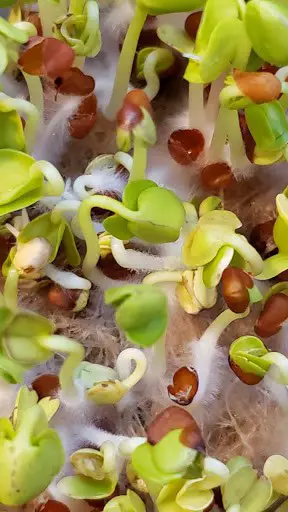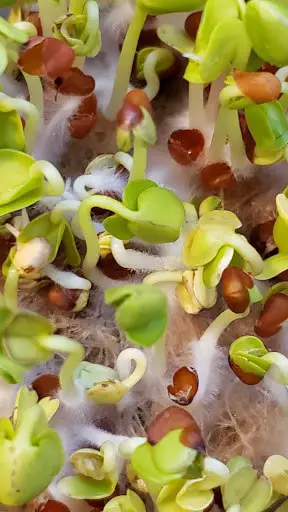I have recently started growing microgreens at home. Growing microgreens is one of the simplest and fastest ways to produce your own food, especially during winter. Within days of planting, you will be harvesting a nutrient-packed crop of microgreens. Although growing microgreens is generally an easy process, I have been running into issues with mold. So I did a little research.
Sometimes microgreen growers confuse root hairs with mold. Root hairs look like little hairs while mold has a cobweb appearance. To prevent mold from growing on your microgreens, make sure they are in an area with good air circulation and relative humidity between 40 and 60 percent.
The rest of this article will detail what I have learned as I researched everything I could find about mold and microgreens.
Mold vs. Root Hairs
Before assuming your microgreens are infested with mold, verify that you are not seeing root hairs. Mold will look like a spiderweb. In contrast, root hairs look like little fuzzy hairs growing from the stems of your microgreens.
You may have to look very closely to be able to tell whether your microgreens are infested with mold or growing root hairs. If you still are not sure whether you are seeing mold or root hairs, there are a few things you can try to get a better idea of whether your microgreens have a mold problem.

The Spray Test For Determining The Difference Between Mold and Root Hairs
One easy way to tell whether you are seeing mold or root hairs is to gently spray or water your microgreens from the top. If the white fuzzy look disappears, there is a good chance your microgreens are growing root hairs. Mold will not disappear after rinsing.
Stage of Microgreen Growth
You are more likely to see root hairs when your plants are very young and just emerging from their seed.
If your plants are nearly at the microgreen stage of growth, you may still see some root hairs at the intersection of the stem and the growing mat. However, if you see a mass of white fuzzy growth above the growing mat, it is probably mold. Double-check using the spray test.
Do Your Microgreens Look Healthy?
If you are not sure whether your plants have been infected with mold or are growing normal root hairs, wait a few days. Eventually, the plants will start to look weak and unhealthy.
Other Indicators That Your Microgreens May Have Mold
A musty odor is a good indication that your plants are infected with mold. In addition, mold is slimy.
If the white, fuzzy stuff in question is covering more than one stem, there is a high probability that it is mold. If the mold is covering only a few stems, try digging out the stems to avoid further contamination. Then correct any further issues. Read on to learn what those potential issues could be.
Mold Commonly Found on Microgreens
Mold is a type of fungus that grows in multicellular filaments called hyphae. Hyphae look like hollow, threadlike structures. Mold has a spiderweb appearance because these hyphae interweave into a mass called mycelium.
It is estimated that there are over 1.5 million species of fungi in the world. The most common type of mold that grows on microgreens (and other plants) is saprophytic fungus, which is the largest group of macro fungi. This type of mold has a white, fuzzy appearance and releases enzymes in order to break down plant material. Saprophytic fungus is not pathogenic to humans or animals (Lucca, 2007).
The fungus can adversely impact the growth of your plants because the fungus and microgreens are competing for nutrients. This happens above and below the surface of the soil or growing medium.
Some types of mold are phytopathogenic, cause disease, or even produce toxins that are harmful to humans and animals (Lucca, 2007).
Causes of Mold
Excess Moisture
Mold needs moisture to grow. Although microgreens need water to grow, it is very important to not overwater. Because microgreens have shallow roots, they should be watered daily. The soil should be moist but not drenched. When you press your fingers into the soil, it should feel spongy, not muddy.
When growing microgreens hydroponically, make sure the growing pads are saturated during germination. However, once the microgreens are uncovered, the growing pad should only be damp. If the growing pad dries out, replenish the water at the bottom of the tray.
In addition to poor drainage, excess humidity can also promote algal growth. If you live in a humid area, consider purchasing a dehumidifier. Set the dehumidifier to 50-60%.
If you live in a humid area and are growing your microgreens outside, consider reducing the planting density (number seeds per tray) in order to minimize mold growth.
Poor Air Circulation
Poor air circulation is another common cause of mold growth. If you start to see signs of mold and are growing your microgreens indoors, try moving your plants outdoors for improved airflow.
Another option is to place fans near the microgreens growing tray. Increasing airflow will also reduce humidity. However, it is important to keep in mind that fans can blow mold spores to other growing trays.
Poor Choice of Growing Media
A poor choice of growing medium related to the moisture issue discussed previously. Your growing medium should drain well and provide enough aeration for the roots.
Reusing soil or growing pads can also cause mold issues when growing microgreens. Before reusing soil, it is important that you allow the roots and stems of the previous plants to break down. Otherwise, microbes could cause issues for future batches of microgreens. The video below describes how to reuse soil for microgreens.
If you are going to reuse growing pads, it is important to sterilize the pad in order to remove any unwanted nutrients that can promote microbial growth. This involves baking the pads in an oven, soaking the pad in a hydrogen peroxide solution, and doing a final rinse.
Obviously, this process takes a lot of time and effort. That is why many growers recommend just throwing grow pads away or composting them after use.
More Tips for Preventing Mold on Microgreens
Clean Your Containers
To prevent mold growth, make sure you clean the containers you will use to grow microgreens. This will prevent any bacteria or microbes from infecting your next batch of microgreens.
To sterilize your growing trays, clean them with warm, soapy water. Then spray them with food-grade hydrogen peroxide, and let it sit for 20 minutes. Then rinse the growing tray and dry it off with a clean cloth.
Sanitize Your Seeds
Sometimes seeds can also be contaminated. A study conducted at the University of Michigan found that sunflower seeds can be contaminated with aflatoxin, which is a toxic mold. Therefore, it is important to sanitize the seeds.
To sanitize your seeds, mix 4 tablespoons of white vinegar and 4 tablespoons of food-grade hydrogen peroxide in a quart of water. Then soak your seeds in the solution for 10 minutes.
Another option is to use grapefruit extract. Grapefruit extract is a powerful disinfectant. To use it to sterilize seeds, add two drops to a quart of water. Then soak your seeds in the solution for 10 minutes.
Use a Sterile Growing Medium or Soil
It is important to use a sterile growing medium if you are growing your microgreens hydroponically. If you are planting your microgreens in soil, use potting soil from a bag rather than from your yard.
Avoid Overseeding
Overseeding can also make mold growth worse because as the plants grow, the higher density of stems can cause poor air circulation. Overseeding makes microgreens particularly susceptible to mold in hot and humid conditions. During the summer, it may be a good idea to reduce the planting density of your microgreens by up to 50%.
Adjust Humidity
As discussed previously, a higher relative humidity promotes mold growth. If your microgreens are growing in a particularly humid location, use a dehumidifier to maintain a relative humidity between 50 and 60.
Increasing airflow will also reduce the relative humidity.
Finally, lowering the air temperature will also reduce the humidity. This is because the air can hold more water vapor at higher temperatures.
How to Remove Mold
If mold has started growing on your microgreen trays, you do not have to throw them out right away. There are a few things you can try to remedy the situation and prevent crop loss.
Spray Your Microgreens With A Disinfectant Solution
First, put a few drops of hydrogen peroxide or grapefruit extract into a spray bottle and mist your microgreens. Do not make the solution too strong, or you will burn the leaves of your plants.
The citric acid in the grapefruit extract will kill the mold, and it acts as a natural disinfectant. Hydrogen peroxide kills mold by releasing oxygen. This process oxidizes the surface of the mold, which in turn decomposes it.
Try Growing Your Microgreens in Soil
It is true that many microgreens can be grown in soil or hydroponically. However, many growers find that it is easier to control mold when their microgreens are planted in soil. If you live in a humid area or continuously have issues with mold, trying growing in soil.
Although you cannot move your microgreens from a hydroponic to a soil environment in the middle of their growth, this may be a tip to keep in mind for future microgreen growing projects.
Remove Infected Areas If Only A Small Area Is Affected
If the mold is only covering a small area, remove the infected stems to prevent it from spreading. Then mist the rest of the growing tray with a grapefruit extract or hydrogen peroxide solution.
Use A Fan to Circulate Air
As discussed previously, poor air circulation can cause mold. Use a fan to blow air on the microgreen tray for a couple of days and see if that gets rid of the mold. Alternatively, you can place your microgreen tray outside.
Is it okay to eat microgreens infected with mold?
Never attempt to eat microgreens infected with mold. Although some types of mold are not dangerous to humans, it is likely that bacteria will grow alongside the mold. For this reason, the United States Department of Agriculture (USDA) recommends throwing away soft fruits and vegetables that are moldy.

